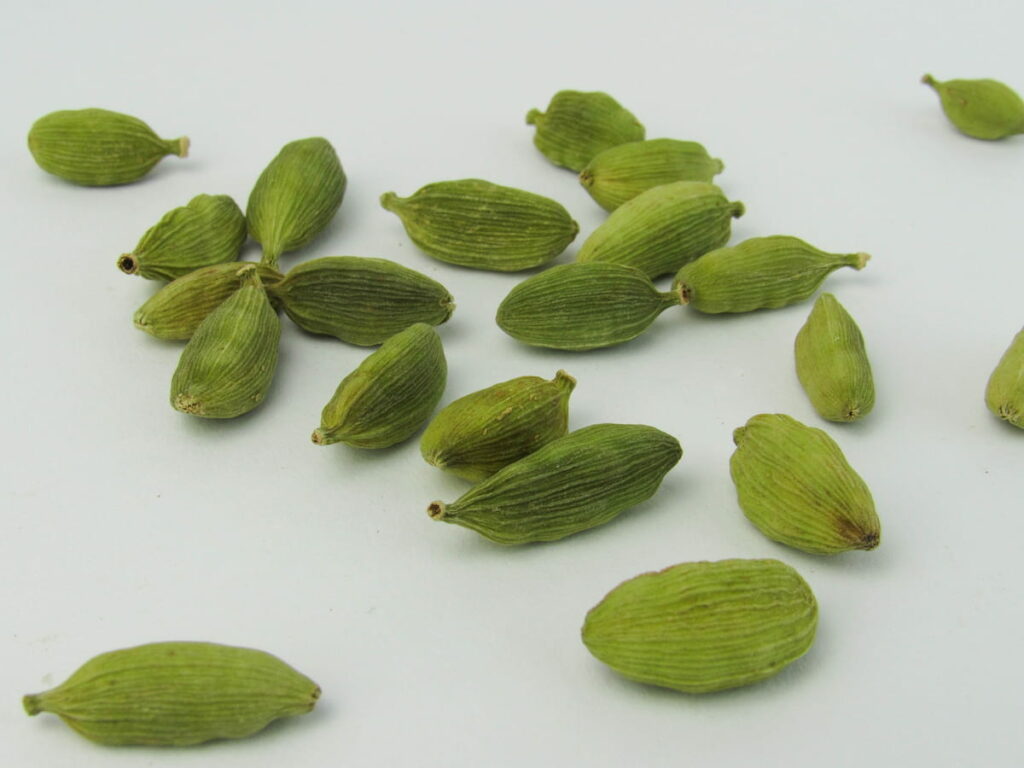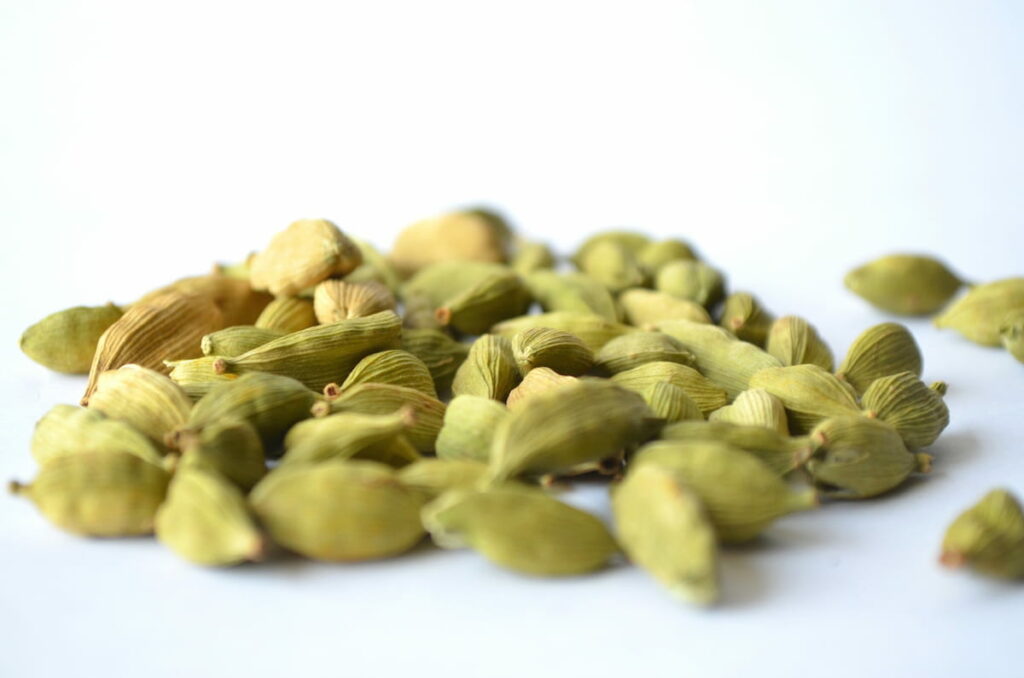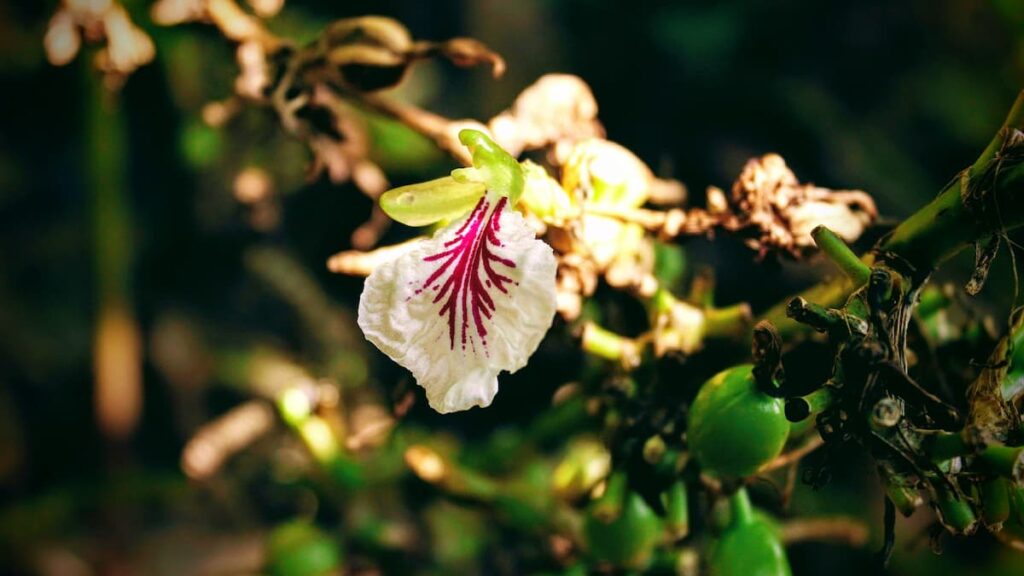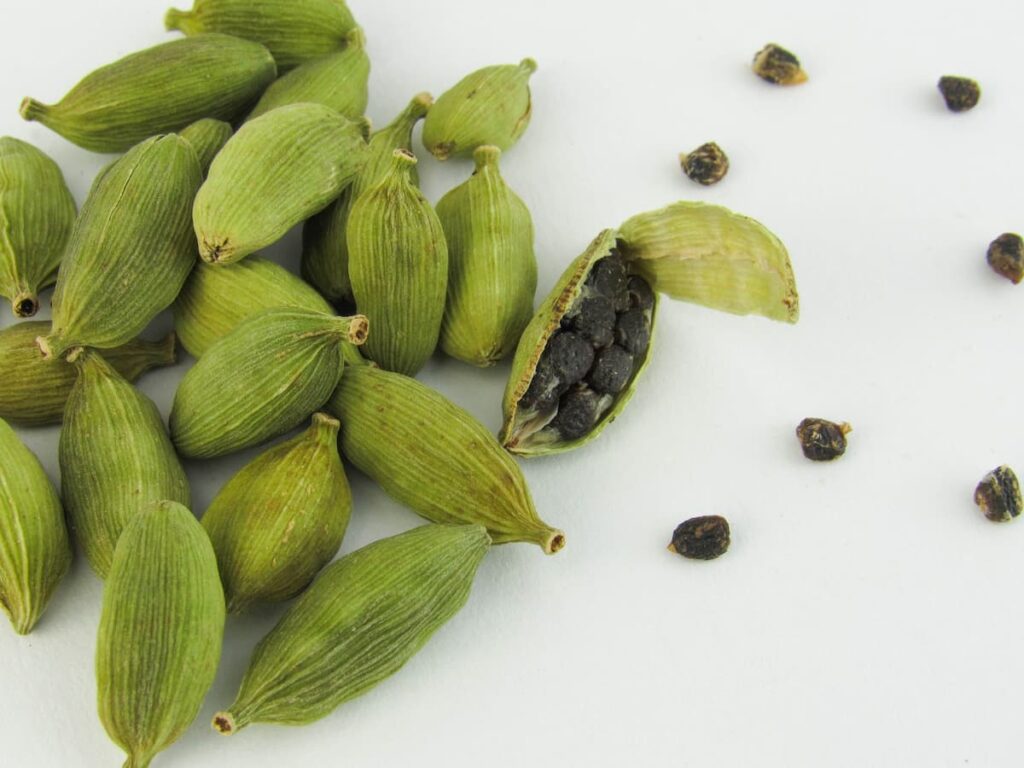Cardamom plants are fragrant spices with an earthy, warm flavor. Cardamom is a spice that has been used for centuries. It is known for its anti-inflammatory and antimicrobial properties, which makes it an excellent addition to cooking. Cardamom plants are also grown from Cardamom seeds. Pods contain small black Cardamom seeds with a strong taste and hints of Lemon, Camphor, and Mint.

Cardamom can grow 6 to 15 feet tall outdoors in tropical climates on cane-like stems. In late spring or summer, leafless flower stems grown from the base and produce white to pale yellow-green flowers with lilac-purple veins and pink or yellow margins. Depending on the variety, the hairy stems are either horizontal or straight. These 1 to 2-inch-long flowers give way to small, fragrant, light yellowish-green fruit pods. Each vertical, thin-walled, smooth-skinned pod is about 3/4 an inch long and has 15 to 20 aromatic black-to-reddish-brown seeds.
How to grow Cardamom (Elaichi) from seeds
Types of Cardamom
Grocery store Cardamom seeds are often harvested before their pod’s bloom, so some seeds will be too immature to grow. Therefore, you should get fresh and untreated Cardamom seeds from the seed seller instead of your grocery store for the best results.
- Green Cardamom – Whether you’re cooking a sweet dish or delicious, green Cardamom is your best choice. It is the most popular variety and is sold in grocery stores worldwide. Green Cardamom pods are green and filled with flavors.
- Black Cardamom – The pods are large and black in color. You can use it as a whole or as powder. Black Cardamom is not suitable for sweet dishes as it has a biting taste.
Climate suitable for growing Cardamom from seed
The Cardamom plant requires an average temperature of at least 10°C to thrive. Cardamom flowers and fruits grow only in tropical conditions, so plant Cardamom where the daily temperature rarely drops below 23°C. If the temperature reaches below 10°C, the growth of plants will be most dramatically damaged.
While flowers and fruits rarely grow indoors, Cardamom can make a beautiful houseplant. Place the plant on a dish of consistently moist pebbles. The houseplant will be much smaller than the outdoors, a modest 2 to 4 feet tall.
In case you missed it: How to Grow Spices in Pots at Home: Garlic, Ginger, Fenugreek, Turmeric, Clove, Cumin, and Cardamom

Soil requirement for growing Cardamom from seed
Both loamy and sandy soil is the correct type of soil for Cardamom. Don’t try to grow herbs in clay or heavy soil, whatever you do. The soil retains water which causes the rhizome to rot. Cardamom prefers neutral soils, so ensure your soil pH is between 6.1 and 6.6. If you have acidic soil with a pH level of less than 6, you can combine a good portion of perlite to reduce acidity.
The key to growing Cardamom is the suitable substrate, which should be well drained so the water can quickly drain out, but the soil should remain constantly moist. Being damp does not mean moist or water-logged soil; the clayey texture is also not recommended because it kills the plant.
Water requirement for growing Cardamom from seed
Cardamom requires much water, but it does not tolerate water-logged soil. Providing the soil is constantly moist, it will continue to grow and bloom yearly. During the summer months, you may have to water it once each day. You can cut down irrigation twice a week when the weather cools down. Cardamom grows in rainforests. These areas mostly receive 200 days of rainfall annually. So, keeping the soil moist is important, and never letting it dry. Add water in the summer or when the plant is bearing fruit.
Germinating Cardamom seeds
- Growing Cardamom is quite tricky. The plant has specific growing conditions and will not grow well if each of these conditions is not met. Cardamom requires tropical, warm-to-hot temperatures and requires high humidity conditions. Cardamom naturally grows in highly humid areas, such as tropical forests, where temperatures range between 19°C to 30°C and humidity levels are up to 75 percent humidity.
- You should prepare Cardamom seeds for sowing. Place the Cardamom seeds in a glass jar, and then place the glass jar into a tray filled with cold tap water. The water should come halfway to the sides of the jar. Gently pour a 2.5% nitric acid solution into the jar of Cardamom seeds. Coat all levels of seeds. Stir the seeds with a spoon. After two minutes of stirring, remove the nitric acid solution from the jar with a sieve.
In case you missed it: How to Grow Medicinal Plants in the Backyard: Medicinal Herb Gardening for Beginners

- Wash the Cardamom seeds under running water. You should transfer the Cardamom seeds to a bowl of lukewarm water and let them soak overnight. This scarification breaks the hard coat of Cardamom seeds. Select a place in the garden for Cardamom seeds. Cardamom prefers moist soil that is rarely dried. It thrives in a filtered shade.
- You can plant Cardamom seeds directly in the garden after the frost danger is over. Sow Cardamom seeds about 1/8 inch on top of the soil. Make rows 4 to 6 feet apart. With a thin layer of soil, you can cover the Cardamom seeds and water deeply until the soil feels moist. Germination of Cardamom usually takes between 20 to 25 days, but it can take up to 40 days. Remove most mulch when germination occurs, leaving only a thin layer around the plants. Provide an overhead shade to protect the plants from the bright sun.
Growing Cardamom from seeds in pots
- If your area temperatures sometimes drop below 16°C, you may want to plant in large pots instead of outdoors in the garden. Choose as large a pot as you can for your space if you use pots. It’s also easy to lift so that you can move it indoors and outdoors of your home. If you need to bring Cardamom indoors, consider keeping it in the warmest room in your home.
- Fill containers with loamy soil that should be slightly sandy; drain gradually. You can use any size container if you plan to transplant the seedlings to your garden. If you leave the seeds in the container, you should use a pot at least 1 foot deep and 6 inches wide. You should push Cardamom seeds into the containers and cover each seed with 1⁄8 inch of soil. You should water the seeds, so the soil is thoroughly moist.
- Cardamom seeds take 40 days to germinate from sowing. This means that you should see that Cardamom plants start poking through the soil. Cardamom also prefers temperatures between 18°C and 35°C. Water well, and until you see at least two leaves on the seedlings, you should leave the seedlings in the container. Cardamom seedlings will take around 90 days for the seedlings to grow big enough to be transplanted outside. When growing fruits, Cardamom plants will require more water during the summer. Plan to give as much water as possible during these months.
In case you missed it: Custard Apple Diseases and Pests (Sugar Apple): Anthracnose, Black Canker, Diplodia Rot, Leaf Spot, Symptoms, Causes, and Prevention

Transplanting Cardamom seedlings
- Choose an organic fertilizer with a high phosphorus content. Spread it in the soil two times a month around Cardamom plants in the summer growing season. To add nutrients to the soil, you should mix aged manure or compost into the soil once a year. Cardamom prefers humus-rich soil, slightly on the acidic side. Transplant to outdoors when you see two pairs of true leaves. Grow outdoors in summer or year-round in warm regions. Please pay attention to the soil after heavy rain to see how it drains. The best soil for growing Cardamom is loamy, with a pH between 6 to 6.6.
- Cardamom plants will die in direct sunlight, so you should choose a planting area with partial shade. It will work if you only have a completely shaded space, but the plant may not grow as quickly. Cardamom needs high humidity to thrive in your garden. The moisture needs to be around 75% to plant the Cardamom outside.
- Plant Cardamom seedlings 1 to 1 1⁄2 inches deep. Dig 1-inch-deep holes that are 6 to 18 inches apart. If you want to help plants grow, drive a garden stake in the soil 2 inches away from the base of each plant. Avoid planting seedlings too deep as they cannot succeed if they don’t get proper sun.
In case you missed it: How to Grow Blackcurrants from Seed to Harvest: Check How this Guide Helps Beginners

Fertilizer requirement for growing Cardamom from seed
In addition to being a thirsty plant, Cardamom is also a heavy feeder. It requires a lot of organic compost and fertilizer to grow and mature. You will need to apply customer fertilizer twice a month in the first few years of the plant’s life. Custom means fertilizer should be something like 2-10-6 with a high phosphorus concentration. Fertilizer feeds the plant throughout the year and protects it from diseases.
Pest and diseases of Cardamom
- Aphids can sometimes transmit the Cardamom mosaic virus, Cardamom’s most viral severe disease. To protect your plants from being infected with the virus, keep an eye on aphids and immediately treat the presence of any aphids you see. Minor aphid infections can be treated by hitting the plant’s leaves with water from the garden hose, knocking out pests with the force of water.
- After a few hours, check back to see if the water blast treatment eliminated the aphids or if the treatment should be repeated. If you’re dealing with a large aphid infection, applying pesticides, spraying with horticultural soap spray, or releasing ladybugs into the garden can help reduce the aphid population.
- Other insects that can attack Cardamom are Cardamom thrips and nematodes. Thrips can be effectively treated by installing traps. Nematodes are challenging to treat. Nematode infection can be identified by looking at poor growth results and plants that look bad. If you think nematodes may be the culprit, dig up a plant and inspect the roots.
- Unfortunately, there is no cure for nematode infections. You should remove plants and destroy them immediately, and the soil may need to be treated with solarization or chemical nematicides to get rid of root-eating pests before replanting.
- Diseases affecting Cardamom plants include rhizome rot, and capsule rot, both caused by waterlogged soil and poor air circulation. To prevent rot problems, ensure you’re planting your Cardamom in well-drained soil and provide enough space between plants to promote enough air circulation. Rotting issues can be avoided by keeping parts of the ground above the plant dry at all times.
In case you missed it: How to Grow Rosemary from Seed to Harvest: Check How this Guide Helps Beginner.s

When and how to harvest Cardamom
The method of harvesting Cardamom spices is to pick each seedpod or fruit by hand. This can be much work, but it may also be worth the effort if you’re particularly fond of spices. Harvest when the seed pod begins to split. That’s how you know they’re ripe and ready for harvesting. The seedpod should be pulled away easily from the plant when tugged. Cardamom can take about three years to grow to maturity, producing its seed-containing capsules. You can harvest flower buds when seed capsules turn green to dry or extract oil from them. Or once the seed capsules are dried and break easily, you can harvest them from the plant.
Conclusion
Growing Cardamom from seed is a time-intensive process that can take many years. So, live up to your expectations and be patient while your herb takes time to grow and mature. The seeds have a hard shell that requires special treatment to germinate. It will take years for the plants to mature and reach their full height. Depending on weather conditions, your exotic perennial may start producing seeds in its third year. But don’t panic if it takes you up to 5 years to get a taste of your homemade Cardamom flavors.
- Broccoli Seed Germination and Selection
- Asparagus Seed Germination and Variety Selection
- Seasonal Flower Gardening: Best Practices for Spring, Summer, Fall, and Winter
- How to Grow Hibiscus from Flower
- Plantation Ideas for Home Decoration: A Beginners Guide
- Flower Garden Designs and Layouts for Beginners
- Planting and Spacing Techniques in Papaya: A Beginner’s Guide
- Growing Gold: Essential Techniques for Planting Pineapples
- How to Make Kalanchoe Plant Bushy: Home Remedies and Solutions
- 11 Reasons Why Your Gardenia is Not Blooming: Home Remedies and Solutions
- Eco Elegance: The Guide to Designing a Drought-Tolerant Landscape
- Gardening on a Slope: Strategies for Hillside Landscaping
- Nourish and Flourish: Top Organic Mulches for Thriving House Plants
- Everything You Want to Know about Indian Mogra Flower: Discover Uses and Growing
- Green Thumb Success: Expert Tips for Cultivating Greenhouse Pumpkins All Year Round
- Maximize Growth & Flavor: The Ultimate Guide to Companion Planting in Herb Gardens
- How to Control Rhododendron Problems Naturally: Home Remedies and Organic Ways to Fix Them
- Natural Magic: The Remarkable Benefits of Cinnamon for Plants
- Best Steps to Revive Dying Tulip with Natural and Organic Treatment
- 10 Reasons Why Your Angel Trumpet is Not Blooming: Remedies and Treatment
- How to Fix Periwinkle Leaf and Flower-Related Problems: Natural Remedies and Solutions
- How to Fix Zinnias Leaf and Flower Problems: Discover Natural and Home Remedies
- Organic Steps to Induce Lemon Tree Flowers: A Comprehensive Guide
- Bloom Booster: Crafting the Perfect Homemade Bougainvillea Fertilizer
- Optimizing Growth: A Guide to Applying NPK Fertilizer for Potted Plants
- 10 Best Homemade Fertilizers for Rubber Plant: DIY Recipes and Application Method
- How to Boost Female Pumpkin Flowers: Effective Steps for More Flowers and High Yields
- Transform Your Indoor Garden: Top Benefits of Pink Salt for Houseplants
- 10 Best Homemade Fertilizers for Peacock Plants (Calathea): Easy DIY Guide
- Unlock Blooms: 9 Reasons Why Your Potted Chrysanthemum is Not Blooming
- 8 Reasons Why Your Potted Hibiscus is Not Blooming: Fix it with Simple Solutions
- Unlock Blooms: 9 Key Reasons Your Potted Frangipani Won’t Flower
- 10 Reasons Why Is My Ice Plant Not Blooming: Remedies and Treatment
- 10 Reasons Why My Potted Hydrangea Not Blooming: Treatment and Remedies
- 10 Reasons Why is My Wisteria Not Blooming: Remedies and Treatment
- 10 Reasons Why is My Goldfish Plant Not Blooming: Remedies and Treatment